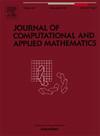热和磁影响下半导体器件换网格问题的数学模型、块心差分及数值分析
IF 2.6
2区 数学
Q1 MATHEMATICS, APPLIED
Journal of Computational and Applied Mathematics
Pub Date : 2025-10-04
DOI:10.1016/j.cam.2025.117130
引用次数: 0
摘要
热磁影响下半导体器件的数值模拟是信息科学中的一个基础性问题。本文从数学模型、数值方法和理论分析三个方面进行了探讨。四个主要的物理未知数(电势、电子浓度、空穴浓度和热量)由几个非线性偏微分方程、一个椭圆方程、两个对流扩散方程和一个导热方程定义。采用具有保守性的块心数值方法获取势,提高了计算精度。对于其他变化网格的偏微分方程,采用迎风块中心差分法求解。扩散算子和对流算子分别采用块心差分和迎风差分离散化。变换网格是模拟pn结附近状态的有效方法。复合方案避免了数值色散和非物理振荡,保持了守恒性。同时计算未知数及其伴随向量。利用能量范数估计、对偶方法和数学归纳法等理论方法完成了收敛性分析。对误差结果进行了总结。最后通过数值算例说明了该方法的有效性和应用前景。本文章由计算机程序翻译,如有差异,请以英文原文为准。
Mathematical model, block-centered difference and numerical analysis on changing meshes of semiconductor device problem with heat and magnetic influences
Numerical simulation of semiconductor device with heat and magnetic influences is a preliminary problem in information science. In this paper, mathematical model, numerical method and theoretical analysis are discussed. Four major physical unknowns (the potential, electron concentration, hole concentration, and the heat) are defined by several nonlinear PDEs, an elliptic equation, two convection–diffusion equations and a heat conductor equation. A block-centered numerical method with conservative nature is used to obtain the potential, and the computational accuracy is improved. An upwind block-centered difference method is adopted for solving other PDEs on changing meshes. The diffusion and convection operators are discretized by block-centered differences and upwind differences, respectively. Changing meshes are effective for simulating the status nearby P-N junction. The composite scheme avoids numerical dispersion and nonphysical oscillation, and the conservation is preserved. The unknowns and their adjoint vectors are computed at the same time. Some theoretical techniques such as energy norm estimates, the method of duality and mathematical induction are used to finish convergence analysis. Error results are concluded. Finally, numerical examples show the efficiency and possible application.
求助全文
通过发布文献求助,成功后即可免费获取论文全文。
去求助
来源期刊
CiteScore
5.40
自引率
4.20%
发文量
437
审稿时长
3.0 months
期刊介绍:
The Journal of Computational and Applied Mathematics publishes original papers of high scientific value in all areas of computational and applied mathematics. The main interest of the Journal is in papers that describe and analyze new computational techniques for solving scientific or engineering problems. Also the improved analysis, including the effectiveness and applicability, of existing methods and algorithms is of importance. The computational efficiency (e.g. the convergence, stability, accuracy, ...) should be proved and illustrated by nontrivial numerical examples. Papers describing only variants of existing methods, without adding significant new computational properties are not of interest.
The audience consists of: applied mathematicians, numerical analysts, computational scientists and engineers.

 求助内容:
求助内容: 应助结果提醒方式:
应助结果提醒方式:


